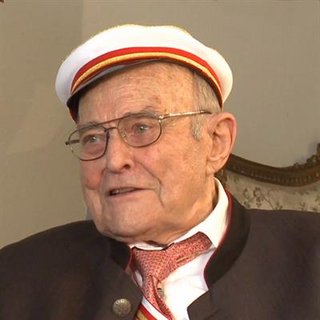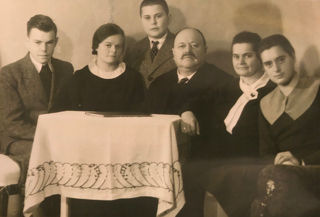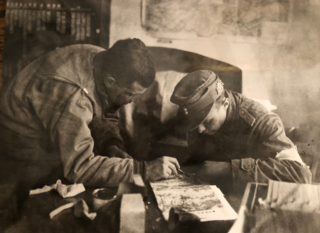Dr. Ludwig Steiner

Personalia
Born:
Died:
Profession:
Persecution:
Resistance fighter (undiscovered)
Memberships
Curriculum Vitae
Ludwig Steiner attended primary and secondary school in his birthplace of Innsbruck. He reports on the incidents at the Anschluss, including:
"We [the youth group at the Jesuits in Innsbruck under the leadership of Fr. Dr. Alois Schrott (1905-1980)] were bitterly disappointed when the federal government's call to avoid hostilities was heard on the radio. I was particularly shocked by the manhunt that began immediately; the president of the Chamber of Labor was arrested and beaten in our house on the night of the revolution; I was also impressed by the tearing down of the red-white-red flag from the barracks of the 6th Mountain Brigade Command by federal police officers with swastika armbands in front of a cheering crowd."
To escape membership of the Hitler Youth, he and a group of friends from the Catholic Youth and the Boy Scouts founded a youth mountain guard.
"We had normal paramedic training and also did exercises and rescue missions. That's how we escaped the HJ."
.
His father Ludwig (1872-1941) was arrested in September 1939 as a Christian-socialist local councillor in Innsbruck and held in police custody for some time before being transferred to Dachau concentration camp. During this time, Ludwig Steiner was taken away from school to the Gestapo four times in order to obtain further incriminating material against his father, "because they obviously had too little accusatory material. [...] I was interrogated about this for hours. There were also beatings if the interrogation did not proceed as desired."
In 1941, Ludwig Steiner graduated from the commercial academy in Innsbruck. He was then called up to the Reich Labor Service [RAD] in the Derneburg labor camp near Hildesheim/Lower Saxony and deployed to Cognac in France in April. He was then drafted into the German Wehrmacht in the Gebirgsjäger Ersatzbataillon 136 (Geb.Jg. Ersatz Btl. 136) in Innsbruck. Because his "external service aptitude is not given", he is not promoted to officer at the war college in Wr. Neustadt. As a member of the 2nd Mountain Division, 2nd Battalion of the 1st Battalion 136, he was seriously wounded in 1943 during an operation on the Arctic Ocean front [Sapadnaya Liza] 34 km from Murmansk. After his recovery, he returned to Geb.Jg. Ersatz Btl. 136 in Innsbruck and became battalion adjutant there.

"Another problem was how to establish international contacts. We also saw the point of resistance activities in making the bombing of Innsbruck and Tyrol militarily superfluous. We were aware that Tyrol was a particularly sensitive point on the north-south and east-west supply route. In this context, we were very interested in finding ways to establish contacts with the Americans or the British.
[...]
It was important to establish contacts with the members of the so-called student companies in Innsbruck, in which officers and soldiers who had been released for studies were grouped together, e.g. doctors, technicians, chemists, etc.. Connections could be established with great reliability via one or other university professor or in cooperation with illegally active Catholic student associations. However, these students were usually only assigned to study for one semester."
In November 1944, the Geb.Jg. Ersatz Btl. 136 was relocated from Salzburg to Wolfsberg in Carinthia by order of General Command XVIII. This threatened to break up the previous resistance work. At the end of January/beginning of February 1945, Ludwig Steiner was granted study leave until the end of the war and so he and a few like-minded friends, including Major Heine, were able to resume their resistance activities in Innsbruck and expand them through new contacts and support for the student companies.

Karl Gruber alias "Dr. Brand" returns from Berlin in March 1945 and now becomes the political head of the resistance; Ludwig Steiner contacts him immediately.
"The first conversation was impressive right from the start. Dr. Gruber said: 'Yes, look, we are now in a situation where no one has to be afraid of the Gestapo anymore. The Gestapo must be afraid of us. [...] The actual activities to take power in Innsbruck began on April 30 and May 1. The military task force under the political leadership of Dr. Gruber and the military leadership of Major Heine went into action. The plan was to first take over the barracks and then try to occupy certain important facilities, such as the transmitter in Aldrans, the Landhaus and other positions, and to secure important transport routes."
"[...] Innsbruck must be liberated before the Americans arrive", Karl Gruber swore everyone involved to secrecy. The party and Wehrmacht leaders gathered in the casino on the Hungerburg were captured in a coup d'état. On the afternoon of May 2, 1945, all of Innsbruck's Wehrmacht barracks and the gendarmerie barracks were in the hands of the resistance groups without bloodshed. After the capture of the Landhaus in Innsbruck on May 2, 1945, Ludwig Steiner makes contact with the approaching American troop units of the 103rd US Infantry Division ("Cactus Division") in Reith near Seelfeld. He wore an armband with the two-language stamp "Austrian movement of Liberation - 05 - Tyrol" or "DIE ÖSTERREICHISCHE WIDERSTANDS-BEWEGUNG - 05".
He played a key role in the liberation of Innsbruck. On the evening of 3 May, the American troops were able to march into Innsbruck.
Ludwig Steiner began his studies in economics at the Faculty of Law and Political Science at the University of Innsbruck in 1943, interrupted by military service and exempted in February 1945 until the end of the war; after graduating in 1947 with a degree in economics [Dipl.- Vw.He completed his studies in 1948 with a doctorate in economics (Dr. rer. soc. oec.
Immediately after the end of the war, Ludwig Steiner also became politically active: he co-founded the ÖVP in Tyrol, initially as secretary to the provisional governor of Tyrol, Karl Gruber, in 1945 and to the mayor of Innsbruck, Anton Melzer, from 1946 to 1948; he also became a member of the provisional Tyrolean provincial parliament in May 1945. In 1948, he joined the diplomatic service at the Federal Chancellery in Vienna, became a member of staff at the Austrian Embassy in Paris, envoy in Sofia, State Secretary, Ambassador in Athens and then took over the management of the branch office of the Federal Chancellery in Innsbruck.
Places
Residence:
Multimedia
Citations
- Krause, Peter/Reinelt, Herbert/Schmitt, Helmut (2020): Farbe tragen, Farbe bekennen. Katholische Korporierte in Widerstand und Verfolgung. Teil 2. Kuhl, Manfred (ÖVfStG, Wien), p. 338–340.
